Through some munificent twist of fate, I was among a select group of moto-journalists invited to go inside the belly of Harley-Davidson's top-secret Product Development Center located in Milwaukee. Never heard of it? PDC, as everyone in denim calls it, is the engineering and stylistic hub of all things single crankpin and 45 degrees between centerlines. It was quite a feather in my cap to be there, except I don't wear caps so I put the feather behind my ear like a greaser's coffin nail.
Built in 1997, the PDC is located just north of the old Capitol Drive powertrain assembly facilty (empty now, and for rent cheap!). The PDC sits on ex-snowmobile testing grounds purchased by Harley-Davidson way back when the first Sportsters were released to combat the British invasion. Legend has it there’s still snowmobile trails in the woods.
Before going into the PDC, we were required to sign a form agreeing not to rat out anything good we saw, including the odd pre-production motorcycle we may accidently bump into. These media restrictions would seem to negate any reason to invite us in the first place, but I try to look at the junket glass as half full. Anyway, Harley’s handlers needn’t have worried about me scooping late-breaking product: I can’t make sense of H-D’s motorcycle range to save my life.
Once inside, our motorcycle gear was stored in the reception area and a stern PDC office-dominatrix covered our cell phone camera lenses with red duct tape. Having clearly established herself as the alpha female, she brusquely strapped us into rubberized, steel-toe overshoes. Then she recited a series of dos and don’ts. The more she scolded us, the warmer the reception room became, and the harder it was to stay focused on motorcycle design. Nervous sweat seemed to please her.
Released from our bonds, we sat while Paul Wiers, Vice President of Engineering, and Ray Drea, Vice President of Styling, gave a presentation explaining the step-by-step birth of a new Harley-Davidson motorcycle. The two speakers were at the logical design extremes: one an engineer, the other an artist. I think I heard Michael Jackson’s “Ebony and Ivory” playing softly in the background. Wiers and Drea told us that new motorcycle designs come from many sources: Harley keeps a dab hand in bike shows, customer demographics, and sales charts, always looking for ways to fill ever-more tightly focused product niches.
How it works is like this, though we didn’t actually see it happening and will have to take our Harley sources at their word: Engineering and Styling, along with Market Research and Product Planning, present a project charter and business plan to a committee for approval. Translation: They want to build a new motorcycle. Once approved, the project goes into prepping the ground, pre-development and execution. It’s very logical and methodical. So terribly Midwestern.
We learned that running prototypes are built at the PDC after the inevitable mockup and scrutinizing phase. There’s even a secure place to test ride motorcycles around here somewhere. More thorough testing is performed at Harley’s Arizona proving ground, just outside the town of…oh, sorry, can’t say. The VPs went on to explain how they, along with the other 549 people at the PDC, work together to make each other’s vision a reality. Sounds like corporate shtick, but my impression was that these guys are sincere about building the best motorcycle they can.
The question and answer period that followed the presentation was a struggle. I don’t know enough about motorcycle product development to even know what to ask and the other journalists weren’t doing much better. I’m trying to think of something not-stupid to say when Aaron Frank leans over and whispers, “Where the @#&@ is your @#&@ note pad, you @#&@?”
Dead air makes me uncomfortable, so I asked the speakers how a crazy motorcycle like the Forty-Eight gets the go signal. I can’t remember the exact answer, on account of forgetting my note pad, but I can tell you it was not, “because Bob said to.”
After the presentation we were led down nondescript, industrial-strength hallways punctuated at intervals by groups of Harley-Davidson motorcycles, posed as though standing around water-coolers skylarking and discussing sports scores or the previous night’s TV talent shows. I’m thinking the cool stuff like 200-horsepower, V-8 sport tourers were cleared out well in advance of our vanguard. Plainclothes Motor Company employees ran sweep to prevent stragglers from poking into The Forbidden Door or pocketing a turkey wrap from the beautiful company canteen.
Since most everything in the PDC is off limits to everyone but the most connected insiders, Harley’s sound room was the main event. The floor of the sound room is isolated from ground vibration. Deep, grey, V-shaped foam blocks cover flat surfaces and an in-floor exhaust-vacuum system allows H-D to tune the potato-potato cadence of its motorcycles without stray audio input. Walking into the room from the harsh-sounding gypsum-board hall brings a sense of peace. Voices hush. The walls of the room absorb sonic waves like the stomach lining of some sort of giant, mechanical Acoustidon.
In the sound room, instead of the motorcycle riding past a microphone, the test bike is tied down on a set of rollers. The room has a series of microphones spaced every foot or so on either side of the bike. By electronically sequencing the mics, the sound room can simulate the motorcycle moving at different speeds. Using this tool, the motorcycle’s audio signature can be massaged to meet the customer’s expectations of a soulful V-twin rumble while still squeaking past government sound regulations.
Kind of funny since the first thing any self-respecting Hog buyer does is saw off the excellent mufflers and hammer on a set of staggered straight pipes using bailing wire and a large rock. Okay, that’s a cheap shot, but deep down you know it’s not far off the truth. The Harley engineers bear it stoically.
Being invited into the inner workings of Harley’s PDC was nice and all but the Mo-Co was so secretive (or maybe just conservative) we really didn’t get to see anything startling. Which makes for an excellent segue into the next tour we were taken on: the Harley-Davidson Accessory Catalog Skunk Works.
Located in a bland, unmarked rent-a-warehouse outside Milwaukee, the Accessory group is in charge of Harley’s ever-growing Shiny Bits division. The crew we met there were polar opposites of buttoned-down company men.
Each year the accessory group gathers to photograph, plan and layout Harley’s two-inch-thick parts catalog. They don’t just shoot the photos for the catalog, they designed a lot of the blingy products and unique-for-any-manufacturer services found within. This joint is where the action is. Speaking with the A team, a fierce entrepreneurial attitude permeates the lingo, giving the Skunk Works the selfless, all hands-on-deck feeling of a family-owned business.
The Accessory division is pushing the leading edge of H-D’s styling far, far forward and for a company who lives and dies by styling, getting shoved in that direction is a good thing. The relatively small accessory team is justifiably proud of its ability to generate big profits for the mother ship. The difference is palatable: Corporate is doing its job, Accessory is on a mission.
Inside the warehouse, the crew built several photo studios and was busy shooting videos and stills of the latest products when we stopped by. Lots of fun things are going on here. The accessory group is behind Harley’s H-D1 online design system. H-D1 offers a customer the ability to see how different parts and color combinations look on a motorcycle mock-up of their design.
The best part of H-D1 is that when you finish playing around on the computer with your dream bike, H-D will build the motorcycle for you! And, unlike that time you extended the flatty forks on your Schwinn Stingray using two-foot lengths of three-quarter inch EMT electrical conduit, the resulting motorcycle won’t kill you from shoddy construction techniques. H-D1 gives the bucks-up H-D buyer that sense of creative accomplishment heretofore reserved for those talented few who can actually build a motorcycle.
The accessory guys are into everything. There’s a cool paint program where you send your tired, faded tin to H-D and get back a factory-original paint job. Can you imagine sending your Pacific Coast bodywork back to Honda for painting? No sane company would waste their time interacting with their customers so intimately.
In the back of the warehouse rows of custom bikes are lined up waiting their moment in the strobe. A few of the bikes look customized beyond functionality, mostly ground clearance or handlebar issues. Attention is lavished on surfaces, whether powder coated, painted or with decorative designs cut directly into metal. The goal: Each Harley rider owning a one-off bike unlike any other in the world. Some of the wild customs we saw may eventually wind up as production bikes. Trying to make them into producible motorcycles must chap the PDC’s hide.
Sadly the cool motorcycles parked here are destined for the crusher after serving as bling mannequins. Don’t fret, everything we saw is available in Harley’s 2013 catalog and has been tested by H-D as warranty safe.
Time is running out for the Skunk Works. Each year the entire operation—the studios, the bikes, all the computers, cameras and lights—evaporates into thin air. It’s a parts catalog Burning Man festival except cracked metallic paint is their godhead.
Permanent buildings, dominatrix receptionists and a clean company canteen are nice perks but not mission critical. Harley’s Accessory team has its priorities straight: the finished product is all that matters and for their customers, what matters most is the finish on the product.













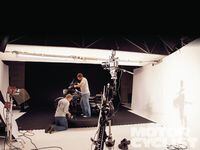

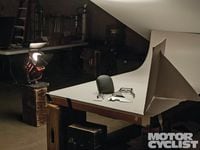

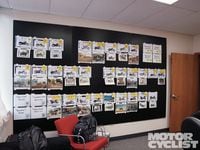

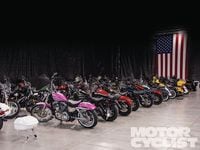
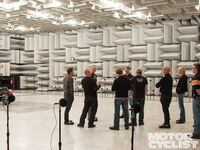
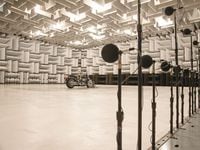
/cloudfront-us-east-1.images.arcpublishing.com/octane/7GJYDUIPXRGMTMQKN6ONYOLBOU.jpg)
/cloudfront-us-east-1.images.arcpublishing.com/octane/MUQLOVLL2ZDGFH25ILABNBXKTI.jpg)
/cloudfront-us-east-1.images.arcpublishing.com/octane/TNOU5DNE2BC57MFPMGN2EIDXAM.jpg)
/cloudfront-us-east-1.images.arcpublishing.com/octane/GTCXACQGJ5HAPDTGWUQKDEH44E.jpg)
/cloudfront-us-east-1.images.arcpublishing.com/octane/S35YGSEMEZB4BLTDJTSZPF4GLA.jpg)
/cloudfront-us-east-1.images.arcpublishing.com/octane/5UOT6HPX2JFMRJAX6EH45AR4MQ.jpg)
/cloudfront-us-east-1.images.arcpublishing.com/octane/OKWOJWAKP5EP3OACCRRWPCIX2Q.jpg)
/cloudfront-us-east-1.images.arcpublishing.com/octane/2WF3SCE3NFBQXLDNJM7KMXA45E.jpg)
/cloudfront-us-east-1.images.arcpublishing.com/octane/G4MG6OUCJNBSHIS2MVVOTPX65E.jpg)
/cloudfront-us-east-1.images.arcpublishing.com/octane/IIGGWFOTOJGB7DB6DGBXCCMTDY.jpg)
/cloudfront-us-east-1.images.arcpublishing.com/octane/QSTCM6AVEZA5JJBUXNIQ3DSOF4.jpg)
/cloudfront-us-east-1.images.arcpublishing.com/octane/U4I7G625B5DMLF2DVIJDFZVV6M.jpg)
/cloudfront-us-east-1.images.arcpublishing.com/octane/B6XD6LS6IVCQPIU6HXDJSM3FHY.jpg)
/cloudfront-us-east-1.images.arcpublishing.com/octane/ICL63FEDDRDTTMINYICCEYGMDA.jpg)
/cloudfront-us-east-1.images.arcpublishing.com/octane/FCGZHQXRBZFLBAPC5SDIQLVF4I.jpg)
/cloudfront-us-east-1.images.arcpublishing.com/octane/WNOB6LDOIFFHJKPSVIWDYUGOPM.jpg)

/cloudfront-us-east-1.images.arcpublishing.com/octane/X33NU3E525ECRHXLNUJN2FTRKI.jpg)
/cloudfront-us-east-1.images.arcpublishing.com/octane/6KKT5NNL2JAVBOXMZYS5ZO76YA.jpg)
/cloudfront-us-east-1.images.arcpublishing.com/octane/J5RKG5O455GMPGQRF2OG6LRT7A.jpg)
/cloudfront-us-east-1.images.arcpublishing.com/octane/GX2CIZKQVRH2TATDM26KFG2DAE.jpg)
/cloudfront-us-east-1.images.arcpublishing.com/octane/ZWIDYSAKQZHD5BHREMQILXJCGM.jpg)
/cloudfront-us-east-1.images.arcpublishing.com/octane/CYUHJZCTSJCH3MRAQEIKXK7SCQ.jpg)
/cloudfront-us-east-1.images.arcpublishing.com/octane/LKOFINY56FCXJCANJ5M7ZDQUBY.jpg)